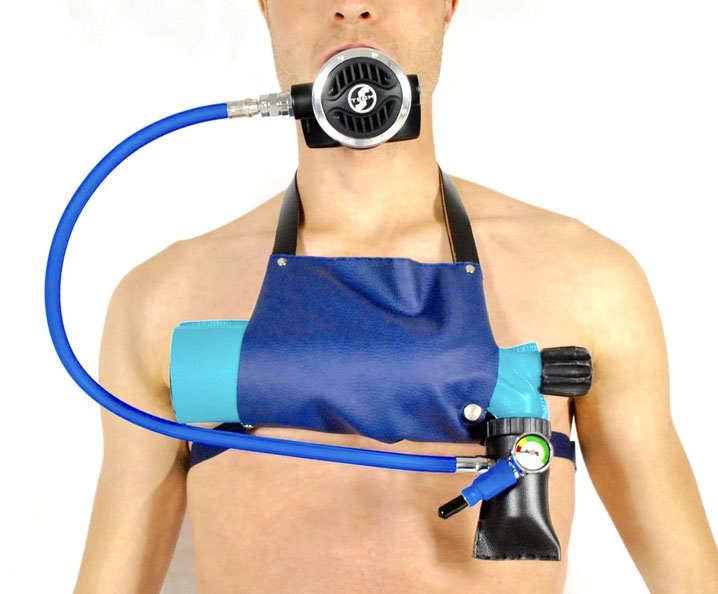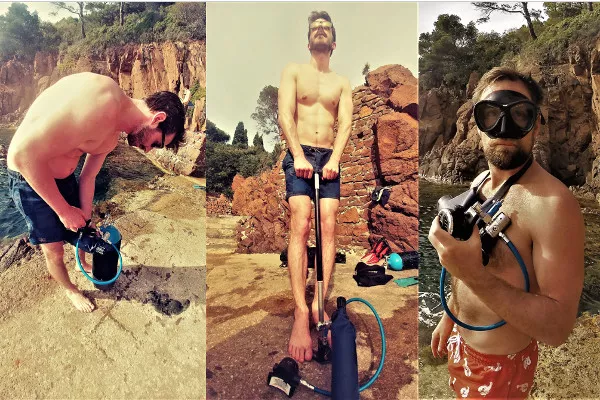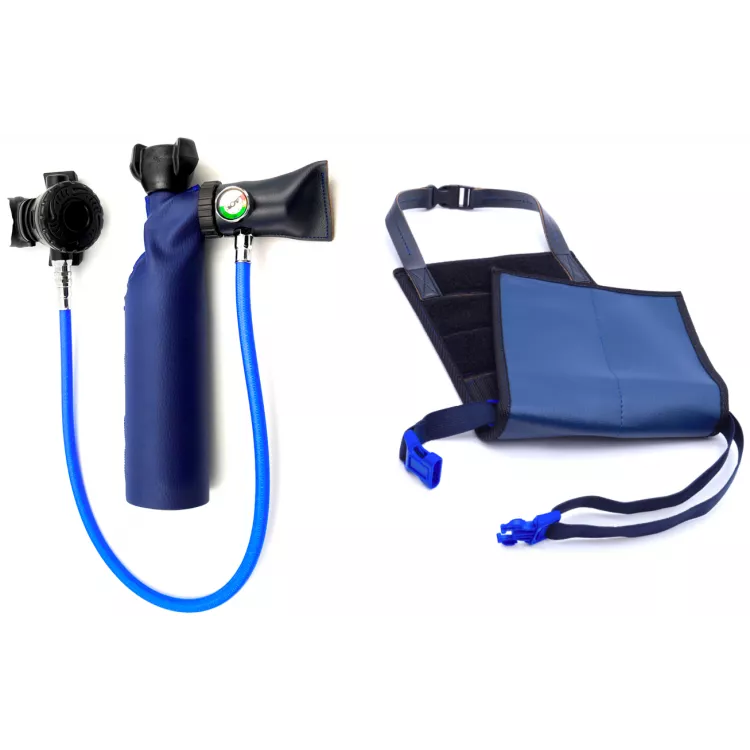MiniDive
In 2001 Brit scuba instructor Rob Hart invented and launched the Mini-B. A complete shallow-water portable aqualung system that came complete with a 3 or 5 litre cylinder and pressure / depth gauge, and a maximum depth recommendation of 9 mt / 29.5 ft.

Hart primarily designed his system to help sailors and boat owners who found themselves in an emergency situation where they needed to repair their boat in a remote location. For instance, to free a fouled prop. It should be noted that the Mini-B is no replacement for experienced trained personnel working on your vessel, but it is a better solution than a snorkel in a "break glass" situation. It was also an efficient set up for dive centres who wanted a 'one size fits all' equipment solution for pool parties and pool dives. The Mini-B was a friendly looking device that would give the user a taste of what it was like to dive scuba before they took the plunge for real on traditional scuba kit.
Now two friends have founded a French start-up company - MiniDive - "to make the [sic] shallow scuba diving accessible to everyone with maximum safety. For this, we have [sic] developed products which are more practical and cheaper than classic scuba diving equipment." I cannot find any merit in this system. It completely fails to deliver on all aspects, and there are currently far better, safer equipment and training solutions in place throughout the world. In my personal opinion, the MiniDive is a dangerous piece of equipment for many reasons.
Training Regime
Lets start with MiniDive's training regime. There isn't one. Instead users are told to read the instruction manual. Let's face it. How many people actually really read a manual when they get a new gadget? Not everyone. The manual is written in badly mashed English and it is confusing. Hands up, my French oral and written language skills are appalling, and MiniDive's English is far better than my written French will ever be.
However when it comes to scuba diving safety, writing instructions in Frongle English is not an option, ie "Regularly control the remaining pressure of the tank with the manometer", and "Never do a rotation (except the ones provided by this purpose) of the element after the pressurizing." This is plain gibberish. It is not safe. It is confusing. It is worth noting here that the 'read the manual' procedure was in use globally, until the 1970s, when it was rejected due to the extreme number of scuba diving fatalities. This was the origins of the RSTC and then the WRSTC. There has been an attempt to explain the golden rule of scuba diving, "always breathe continuously, never hold your breath", but again the key safety message is lost in translation. "Always adopt flexible and continuous respiration." And there is no explanation as to why it is dangerous to hold your breath whilst scuba diving.
The Cylinder
The MiniDive comes complete with a 0.5 litre tank. I fill my AP Valves Delayed Surface Marker Buoy with a tiny 0.4 litre cylinder! MiniDive state their cylinder can be filled in four different ways.
- The handpump [sic], which is simple to use and designed to fill the tank everywhere
- A portable mini-electric compressor, which is easy to carry and can fill the tank quickly
- From another scuba tank via an adaptor
- A standard diving compressor
Most of us will have pumped up a bicycle tyre at some point in our lives. The final few pumps of air into the tyre can be sometimes a bit challenging, so what kind of pressure are we talking? According to Cycling Weekly "tyre pressures can depend on the width of the tyre and the weight of the person riding the bike, ranging from 4 bar / 50 psi to 9 bar / 130 psi."

MiniDive state you can hand pump the 0.5 lt cylinder in 15 minutes. They do not confirm what pressure you can hand pump the 0.5 lt cylinder to, but their website states a "maximal [sic]pressure of 200 bar." Whilst the idea of being able to recharge a cylinder in a remote location appeals, I do fear that MiniDive's statement is overally optimistic. I struggle a bit pumping my tyres to 9 bar...
And then there is the question of the purity of the air provided via the hand pump. In very simple terms divers need to breathe filtered and dehumidified compressed air. Whilst the MiniDive manual does mention that a filter is fitted to the hand pump and it "can be easily unscrewed from the base of the pump to be regenerated every 10 filling [sic]," the information is scant.
I would note that air that is 'marginally' safe on the surface. In smog ridden cities with high CO levels for example, compressed air can have significant health impacts, even in fairly shallow water. This may be overkill given MiniDive's stated depth limit - but how many users will exactly follow the depth limit and be rigorous with changing filters etc?
The Maths Does Not Add Up
Time for a quick maths lesson. Assuming that we do manage to hand pump the cylinder to 200 bar, the user will have 100 litres of air: 0.5 lt cylinder x 200 bar = 100 litres. MiniDive state that their system should not be dived beyond 3 metres. This equates to 1.3 bar of pressure. They also state that the "new patented mini scuba tank [0.5 litres] allows you [sic] 5 to 10 minutes underwater (its depends on the physical activity) for a pleasure [sic] use like [sic]see fishes underwater[sic] or practical use like [sic] check something under a boat."
I really do not know where MiniDive are getting their breathing duration figures from. A typical user will have a breathing rate of at least 25 litres of air on the surface. This figure of 25 litres of air per minute is taught to new divers. As divers gain in-water knowledge their breathing rate comes down, and it is not unknown for an experienced diver to have a breathing rate of 12 litres of air per minute (or less) in benign conditions.
The typical user of the MiniDive will be an untrained person, therefore using a base figure of 25 litres of air per minute is not unreasonable. Using 25 lt / per minute, MiniDive's cylinder will last 4 minutes at the surface.
At 3 metres, or 1.3 bar the breathing rate will change to 32.5 lt per minute (25 lt x bar). Therefore the cylinder will last 3 minutes and a few seconds, yet they state it will give 5 to 10 minutes underwater. Quite a frightening thought.

The MiniDive comes complete with a tiny button pressure gauge that looks as though it will be, at best, challenging to read underwater. It does not seem to lie in a place where the diver will naturally look at it. And MiniDive does not provide a depth gauge. How does the user know what depth they are at? The majority of new divers don't tend to watch their gauges because their entire being is focused on other skills such as breathing and swimming. I cannot therefore see users of the MiniDive regularly monitoring their tiny pressure gauge.
I could go on. But I think it is time to stop asking questions. I cannot see a single use for the MiniDive, not even as emergency breathing apparatus. Frankly I am scared of the number of people who will use the MiniDive and embolise, drown, or suffer from lung over expansion injuries. And what will be result? Scuba diving gets a very bad name for being dangerous. All I can say is, "MiniDive, I hope most sincerely that you have got good public liability insurance. You are doing to need it. This device is badly thought through and potentially lethal."
- Log in to post comments
























